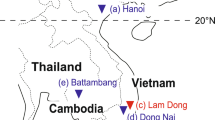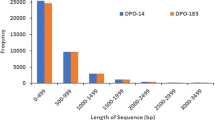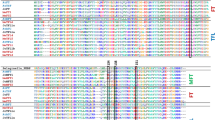Abstract
Key message
We characterized genes that function in the photoperiodic flowering pathway in cassava. Transcriptome analysis of field-grown plants revealed characteristic expression patterns of these genes, demonstrating that field-grown cassava experiences two distinct developmental transitions.
Abstract
Cassava is an important crop for both edible and industrial purposes. Cassava develops storage roots that accumulate starch, providing an important source of staple food in tropical regions. To facilitate cassava breeding, it is important to elucidate how flowering is controlled. Several important genes that control flowering time have been identified in model plants; however, comprehensive characterization of these genes in cassava is still lacking. In this study, we identified genes encoding central flowering time regulators and examined these sequences for the presence or absence of conserved motifs. We found that cassava shares conserved genes for the photoperiodic flowering pathway, including florigen, anti-florigen and its associated transcription factor (GIGANTEA, CONSTANS, FLOWERING LOCUS T, CENTRORADIALIS/TERMINAL FLOWER1 and FD) and florigen downstream genes (SUPRESSOR OF OVEREXPRESSION OF CONSTANS1 and APETALA1/FRUITFUL). We conducted RNA-seq analysis of field-grown cassava plants and characterized the expression of flowering control genes. Finally, from the transcriptome analysis we identified two distinct developmental transitions that occur in field-grown cassava.






Similar content being viewed by others
Change history
03 May 2022
A Correction to this paper has been published: https://doi.org/10.1007/s11103-022-01271-y
References
Abe M, Kobayashi Y, Yamamoto S, Daimon Y, Yamaguchi A, Ikeda Y, Ichinoki H, Notaguchi M, Goto K, Araki T (2005) FD, a bZIP protein mediating signals from the floral pathway integrator FT at the shoot apex. Science 309:1052–1056. https://doi.org/10.1126/science.1115983
Adeyemo OS, Hyde PT, Setter TL (2019) Identification of FT family genes that respond to photoperiod, temperature and genotype in relation to flowering in cassava (Manihot esculenta, Crantz). Plant Reprod 32:181–191. https://doi.org/10.1007/s00497-018-00354-5
Ahn JH, Miller D, Winter VJ, Banfield MJ, Jeong HL, So YY, Henz SR, Brady RL, Weigel D (2006) A divergent external loop confers antagonistic activity on floral regulators FT and TFL1. EMBO J 25:605–614. https://doi.org/10.1038/sj.emboj.7600950
Aikawa S, Kobayashi MJ, Satake A, Shimizu KK, Kudoh H (2010) Robust control of the seasonal expression of the Arabidopsis FLC gene in a fluctuating environment. Proc Natl Acad Sci USA 107:11632–11637. https://doi.org/10.1073/pnas.0914293107
Albani MC, Vincent C, Bergonzi S, Luan M, Bai Y, Kiefer C, Castillo R, Coupland G (2011) Aa tfl1 confers an age-dependent response to vernalization in perennial arabis alpina. Plant Cell 23:1307–1321. https://doi.org/10.1105/tpc.111.083451
Andrés F, Coupland G (2012) The genetic basis of flowering responses to seasonal cues. Nat Rev Genet 13:627–639
Azeez A, Miskolczi P, Tylewicz S, Bhalerao RP (2014) A tree ortholog of APETALA1 mediates photoperiodic control of seasonal growth. Curr Biol 24:717–724. https://doi.org/10.1016/j.cub.2014.02.037
Behnam B, Bohorquez-Chaux A, Castaneda-Mendez OF, Tsuji H, Ishitani M, Becerra Lopez-Lavalle LA (2019) An optimized isolation protocol yields high-quality RNA from cassava tissues (Manihot esculenta Crantz). FEBS Open Biol 9:814–825. https://doi.org/10.1002/2211-5463.12561
Byrne D (1984) Breeding cassava. Plant Breed Rev 2:73–134
Ceballos H, Iglesias CA, Pérez JC, Dixon AGO (2004) Cassava breeding: opportunities and challenges. Plant Mol Biol 56:503–516. https://doi.org/10.1007/s11103-004-5010-5
Cockram J, Thiel T, Steuernagel B, Stein N, Taudien S, Bailey PC, O’Sullivan DM (2012) Genome dynamics explain the evolution of flowering time CCT domain gene families in the Poaceae. PLoS ONE 7:e45307. https://doi.org/10.1371/journal.pone.0045307
Collani S, Neumann M, Yant L, Schmid M (2019) FT modulates genome-wide DNA-binding of the bZIP transcription factor FD. Plant Physiol 180:367–380. https://doi.org/10.1104/pp.18.01505
Conti L, Bradley D (2007) TERMINAL FLOWER1 is a mobile signal controlling Arabidopsis architecture. Plant Cell 19:767–778. https://doi.org/10.1105/tpc.106.049767
Delgado A, Hays DB, Bruton RK, Ceballos H, Novo A, Boi E, Selvaraj MG (2017) Ground penetrating radar: a case study for estimating root bulking rate in cassava (Manihot esculenta Crantz). Plant Methods 13:65. https://doi.org/10.1186/s13007-017-0216-0
Fang X, Wang L, Ishikawa R, Li Y, Fiedler M, Liu F, Calder G, Rowan B, Weigel D, Li P, Dean C (2019) Arabidopsis FLL2 promotes liquid-liquid phase separation of polyadenylation complexes. Nature 569:265
Fleuret P, Fleuret A (1980) Nutritional implications of staple food crop successions in Usambara, Tanzania. Hum Ecol 8:311–327. https://doi.org/10.1007/BF01560998
Hanzawa Y, Money T, Bradley D (2005) A single amino acid converts a repressor to an activator of flowering. Proc Natl Acad Sci USA 102:7748–7753. https://doi.org/10.1073/pnas.0500932102
Huijser P, Schmid M (2011) The control of developmental phase transitions in plants. Development 138:4117–4129
Kaneko-Suzuki M, Kurihara-Ishikawa R, Okushita-Terakawa C, Kojima C, Nagano-Fujiwara M, Ohki I, Tsuji H, Shimamoto K, Taoka K-I (2018) TFL1-like proteins in rice antagonize rice FT-like protein in inflorescence development by competition for complex formation with 14–3-3 and FD. Plant Cell Physiol 59:458–468. https://doi.org/10.1093/pcp/pcy021
Kawamoto N, Sasabe M, Endo M, Machida Y, Araki T (2015) Calcium-dependent protein kinases responsible for the phosphorylation of a bZIP transcription factor FD crucial for the florigen complex formation. Sci Rep 5:8341. https://doi.org/10.1038/srep08341
Kim D, Paggi JM, Park C, Bennett C, Salzberg SL (2019) Graph-based genome alignment and genotyping with HISAT2 and HISAT-genotype. Nat Biotechnol 37:907–915. https://doi.org/10.1038/s41587-019-0201-4
Lim M-H, Kim J, Kim Y-S, Chung K-S, Seo Y-H, Lee I, Kim J, Hong CB, Kim H-J, Park C-M (2004) A new Arabidopsis gene, FLK, encodes an RNA binding protein with K homology motifs and regulates flowering time via FLOWERING LOCUS C. Plant Cell 16:731–740
Lee J, Lee I (2010) Regulation and function of SOC1, a flowering pathway integrator. J Exp Bot 61:2247–2254
Liao Y, Smyth GK, Shi W (2013) The Subread aligner: Fast, accurate and scalable read mapping by seed-and-vote. Nucleic Acids Res 41:e108. https://doi.org/10.1093/nar/gkt214
Macknight R, Bancroft I, Page T, Lister C, Schmidt R, Love K, Westphal L, Murphy G, Sherson S, Cobbett C, Dean C (1997) FCA, a gene controlling flowering time in Arabidopsis, encodes a protein containing RNA-binding domains. Cell 89:737–745
Mockler TC, Yu X, Shalitin D, Parikh D, Michael TP, Liou J, Huang J, Smith Z, Alonso JM, Ecker JR, Chory J, Lin C (2004) Regulation of flowering time in Arabidopsis by K homology domain proteins. Proc Natl Acad Sci USA 101:12759–12764
Nagano AJ, Sato Y, Mihara M, Antonio BA, Motoyama R, Itoh H, Nagamura Y, Izawa T (2012) Deciphering and prediction of transcriptome dynamics under fluctuating field conditions. Cell 151:1358–1369. https://doi.org/10.1016/j.cell.2012.10.048
Nakamura T, Song IJ, Fukuda T, Yokoyama J, Maki M, Ochiai T, Kameya T, Kanno A (2005) Characterization of TrcMADS1 gene of Trillium camtschatcense (Trilliaceae) reveals functional evolution of the SOC1/TM3-like gene family. J Plant Res 118:229–234. https://doi.org/10.1007/s10265-005-0215-5
Satake A, Kawagoe T, Saburi Y, Chiba Y, Sakurai G, Kudoh H (2013) Forecasting flowering phenology under climate warming by modelling the regulatory dynamics of flowering-time genes. Nat Commun 4:1–8. https://doi.org/10.1038/ncomms3303
Satake A, Kawatsu K, Teshima K, Kabeya D, Han Q (2019) Field transcriptome revealed a novel relationship between nitrate transport and flowering in Japanese beech. Sci Rep 9:1–12. https://doi.org/10.1038/s41598-019-39608-1
Sawa M, Kay SA (2011) GIGANTEA directly activates flowering Locus T in Arabidopsis thaliana. Proc Natl Acad Sci USA 108:11698–11703. https://doi.org/10.1073/pnas.1106771108
Simpson GG, Dijkwel PP, Quesada V, Henderson I, Dean C (2003) FY is an RNA 3’ end-processing factor that interacts with FCA to control the Arabidopsis floral transition. Cell 113:777–787
Song YH, Kubota A, Kwon MS, Covington MF, Lee N, Taagen ER, Laboy Cintrón D, Hwang DY, Akiyama R, Hodge SK, Huang H, Nguyen NH, Nusinow DA, Millar AJ, Shimizu KK, Imaizumi T (2018) Molecular basis of flowering under natural long-day conditions in Arabidopsis. Nat Plants 4:824–835. https://doi.org/10.1038/s41477-018-0253-3
Taoka K-I, Ohki I, Tsuji H, Furuita K, Hayashi K, Yanase T, Yamaguchi M, Nakashima C, Purwestri YA, Tamaki S, Ogaki Y, Shimada C, Nakagawa A, Kojima C, Shimamoto K (2011) 14-3-3 proteins act as intracellular receptors for rice Hd3a florigen. Nature 476:332–335. https://doi.org/10.1038/nature10272
Taoka K-I, Ohki I, Tsuji H, Kojima C, Shimamoto K (2013) Structure and function of florigen and the receptor complex. Trends Plant Sci 18:287–294. https://doi.org/10.1016/j.tplants.2013.02.002
Tokunaga H et al (2020) Field transcriptome analysis reveals a molecular mechanism for cassava-flowering in a mountainous environment in Southeast Asia. Plant Mol Biol. https://doi.org/10.1007/s11103-020-01057-0.
Townsley BT, Covington MF, Ichihashi Y, Zumstein K, Sinha NR (2015) BrAD-seq: Breath Adapter Directional sequencing: a streamlined, ultra-simple and fast library preparation protocol for strand specific mRNA library construction. Front Plant Sci 6:366. https://doi.org/10.3389/fpls.2015.00366
Tsuji H (2017) Molecular function of florigen. Breed Sci 67:327–332. https://doi.org/10.1270/jsbbs.17026
Tsuji H, Taoka K-I, Shimamoto K (2011) Regulation of flowering in rice: two florigen genes, a complex gene network, and natural variation. Curr Opin Plant Biol 14:45–52. https://doi.org/10.1016/j.pbi.2010.08.016
Tsuji H, Nakamura H, Taoka K-I, Shimamoto K (2013) Functional diversification of FD transcription factors in rice, components of florigen activation complexes. Plant Cell Physiol 54:385–397. https://doi.org/10.1093/pcp/pct005
Tylewicz S, Tsuji H, Miskolczi P, Petterle A, Azeez A, Jonsson K, Shimamoto K, Bhalerao RP (2015) Dual role of tree florigen activation complex component FD in photoperiodic growth control and adaptive response pathways. Proc Natl Acad Sci USA 112:3140–3145. https://doi.org/10.1073/pnas.1423440112
Wigge PA, Kim MC, Jaeger KE, Busch W, Schmid M, Lohmann JU, Weigel D (2005) Integration of spatial and temporal information during floral induction in Arabidopsis. Science 309:1056–1059. https://doi.org/10.1126/science.1114358
Acknowledgements
This work was supported by MEXT KAKENHI, Grant-in-Aid for Scientific Research on Innovative Areas, Numbers 16H06464, 16K21727 and 16H06466 for H.T., Grant-in-Aid for Scientific Research (A), Number 16H02532, JSPS grant Strategic Young Researcher Overseas Visits Program for Accelerating Brain Circulation and Program for Fostering Globally Talented Researchers to H.S.. This research was undertaken as part of and funded by the CGIAR Research Program on Roots, Tubers and Bananas (RTB) and supported by CGIAR Fund Donors (http://www.cgiar.org/about-us/our-funders/) and USAID.
Author information
Authors and Affiliations
Contributions
BB and HTsuji conceived the research. BB, MGS, MI, LAB and H.Tsuji designed experiments. HC provided genotypic information of cassava cultivars used in this study. BB cultivated plants in the field, sampled and extracted RNA. KY prepared RNA-seq libraries and AH mapped and quantified sequenced reads. HTsuji, AH, HTokunaga, YU and MS analyzed RNA-seq data. BB and HTsuji wrote the manuscript.
Corresponding author
Additional information
Publisher's Note
Springer Nature remains neutral with regard to jurisdictional claims in published maps and institutional affiliations.
The original version of this article was revised: Hernan Ceballos was missing from the authors section.
Supplementary Information
Below is the link to the electronic supplementary material.
Rights and permissions
About this article
Cite this article
Behnam, B., Higo, A., Yamaguchi, K. et al. Field-transcriptome analyses reveal developmental transitions during flowering in cassava (Manihot esculenta Crantz). Plant Mol Biol 106, 285–296 (2021). https://doi.org/10.1007/s11103-021-01149-5
Received:
Accepted:
Published:
Issue Date:
DOI: https://doi.org/10.1007/s11103-021-01149-5




